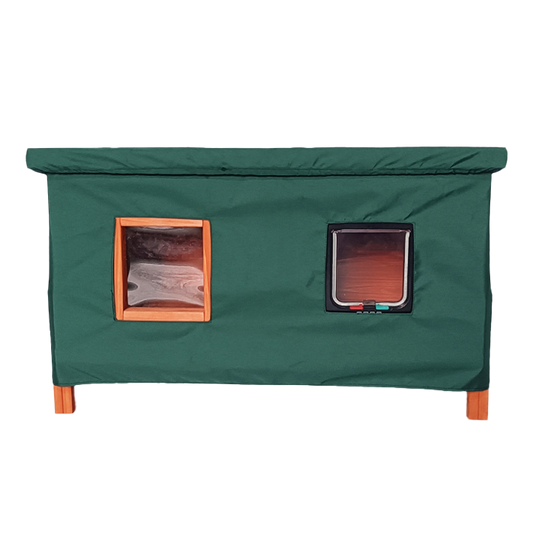Would you know what to do if your dog was stung by a bee or your cat came home with a wounded leg? You may not have considered what you would do in an emergency situation but by learning some basic pet first aid you’ll be less likely to panic and more likely to be able to help. Remember, first aid is no substitute for veterinary attention and your pet should always see a professional as soon as possible for a follow-up examination.
Be Prepared
Don’t wait until your cat or dog is ill or has an accident to think about first aid. Every pet owner should have a basic first aid kit and know where to access it quickly. Some dog owners like to keep an additional one in their car in case of problems when away from home.
Your first aid kit should contain:
- Antiseptic wipes
- Antiseptic wound wash
- A small torch
- Bandages
- Blunt-ended scissors
- Cotton wool
- Disposable gloves
- Dressings
- Foil emergency blanket
- Gauze
- Self-adhesive tape
- Syringes for oral use and eye washing
- Tick hook
- Tweezers
You should also make sure that your vet’s contact details are programmed into your mobile phone and include a copy in your first aid kit. Not all veterinary practices operate an out-of-hours emergency service so make sure you have the number for your closest emergency practice too.
How To Check Your Pet’s Vital Signs
It is very useful for owners to be able to check their pet’s vital signs in the event of illness or accident so that they can identify problems early and report those signs to their vet. Here’s what you need to know:
- Responsiveness – If your pet is not responding to you, use a small torch to shine a light directly into their eyes. The normal response is for the pupil to shrink when light hits it. If this does not happen, it indicates loss of consciousness and you should seek immediate veterinary attention.
- Heart rate – You can find an animal’s heart rate by placing your hand on the left side of their chest, just behind the bend in the front elbow. When you feel the heart beat you should count how many there are in a minute. It helps to use a stopwatch or timer for accuracy.
- These are the normal heart rate ranges you should be looking for:
- Cats = 160-220bpm
- Small dogs = 100-160bpm
- Medium dogs = 60-100bpm
- Large dogs = 60-80bpm
- Puppies and kittens = around 220bpm
- Temperature – The most accurate way of taking a pet’s temperature is with a rectal thermometer. Hold your pet securely while you insert the thermometer carefully into the rectum. It’s usually helpful to have another person to assist by keeping the animal distracted. A reading of under 37.2°c or over 40°c for dogs and cats is considered an emergency and you should seek veterinary assistance as soon as possible.
- Respiratory rate – When an animal is rested and calm, count the breaths in one minute using a stopwatch or timer to help with accuracy. A normal rate for a dog is 15-30 breaths per minute and for a cat is 20-30 breaths per minute. A cat should never be seen breathing through his mouth so if this is the case, seek veterinary attention immediately.
- Oxygen level – The colour of an animal’s gums will let you know if they’re getting enough oxygen. They should be pink so if you see blue, yellow, dark red or brown then there’s something wrong and they should see a vet immediately.
There are organisations that offer full first aid courses for pet owners, which include things like giving artificial respiration and CPR. They provide practice dummies and are the best way to get hands-on experience of what to do in a serious medical situation. However, there are simple skills that all pet owners should learn to treat some of the most common pet problems:
Bee or Wasp Stings
- Identify the area of the sting.
- If you can see a sting present, remove it carefully while trying not to squeeze it. The presence of a sting indicates a bee sting while the absence of a sting would suggest a wasp.
- For a bee sting, mix ¼ cup of bicarbonate of soda with 1-2 teaspoons of water to make a paste and apply to the area. For wasp stings, soak a cotton wool ball in vinegar and apply it with slight pressure to the affected area.
- Keep an eye on the area for signs of swelling.
- If your pet has been stung in the mouth, you should seek immediate veterinary attention as any swelling here could potentially obstruct their airway.
Dressing a Wound
- Learning how to care for a wound correctly will decrease healing time and guard against infection.
- Remove any debris from the wound and clean it with a wound wash or saline solution unless it is bleeding heavily.
- Carefully trim away any fur that is getting into the wound using blunt-ended scissors.
- Apply gentle pressure using some gauze or a cotton pad.
- If the wound requires bandaging, first apply a sterile pad and then gauze to keep the pad in the desired position.
- You can secure the dressing with surgical tape or wrap a bandage around to keep it in place, ensuring it is not so tight that it hinders circulation.
Heat Stroke
Signs of heat stroke include persistent panting, restlessness and saliva appearing thicker than usual. If you suspect your pet is suffering from heat stroke you should:
Check their temperature using a rectal thermometer – above 39°c is abnormal and higher than 41°c can be fatal if untreated.
- Take your pet out of the sun and use cool packs or a fan to cool them down.
- Use cool – not cold – water on their legs.
- Monitor their temperature as you don’t want it dropping too low.
- Make sure fresh drinking water is available but don’t force them to drink.
- Seek veterinary attention as soon as possible.
Make sure you don’t end up becoming the victim yourself by jumping into a situation too early. Remember your own safety first and, if at any point you are unsure of what to do or are worried by anything at all, contact your vet immediately.
If you found this article interesting, you may like:









